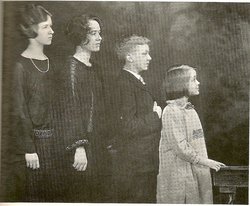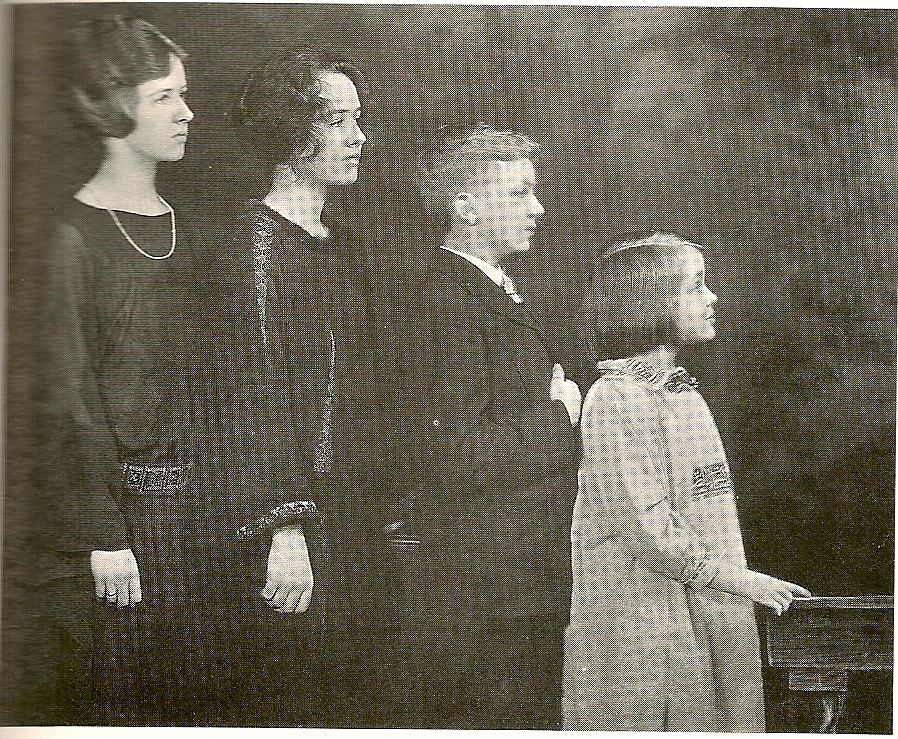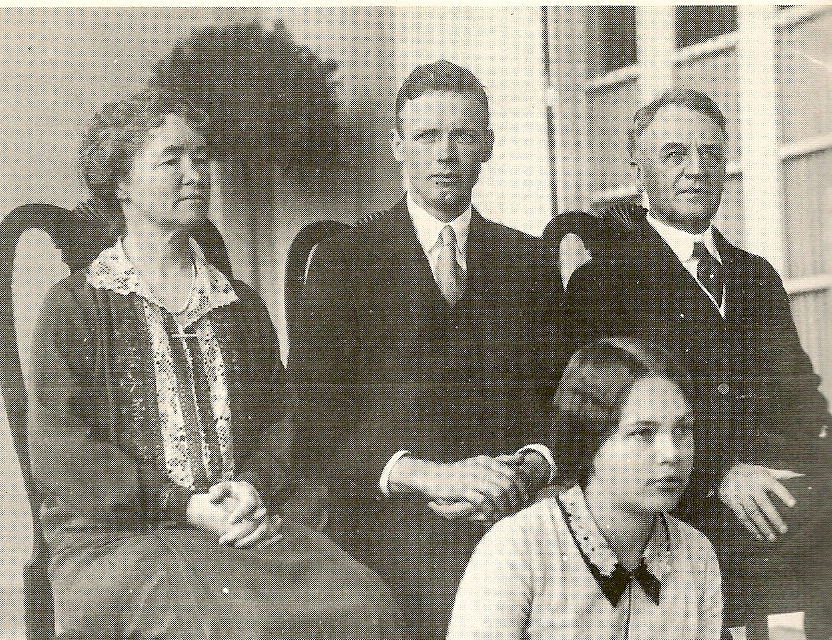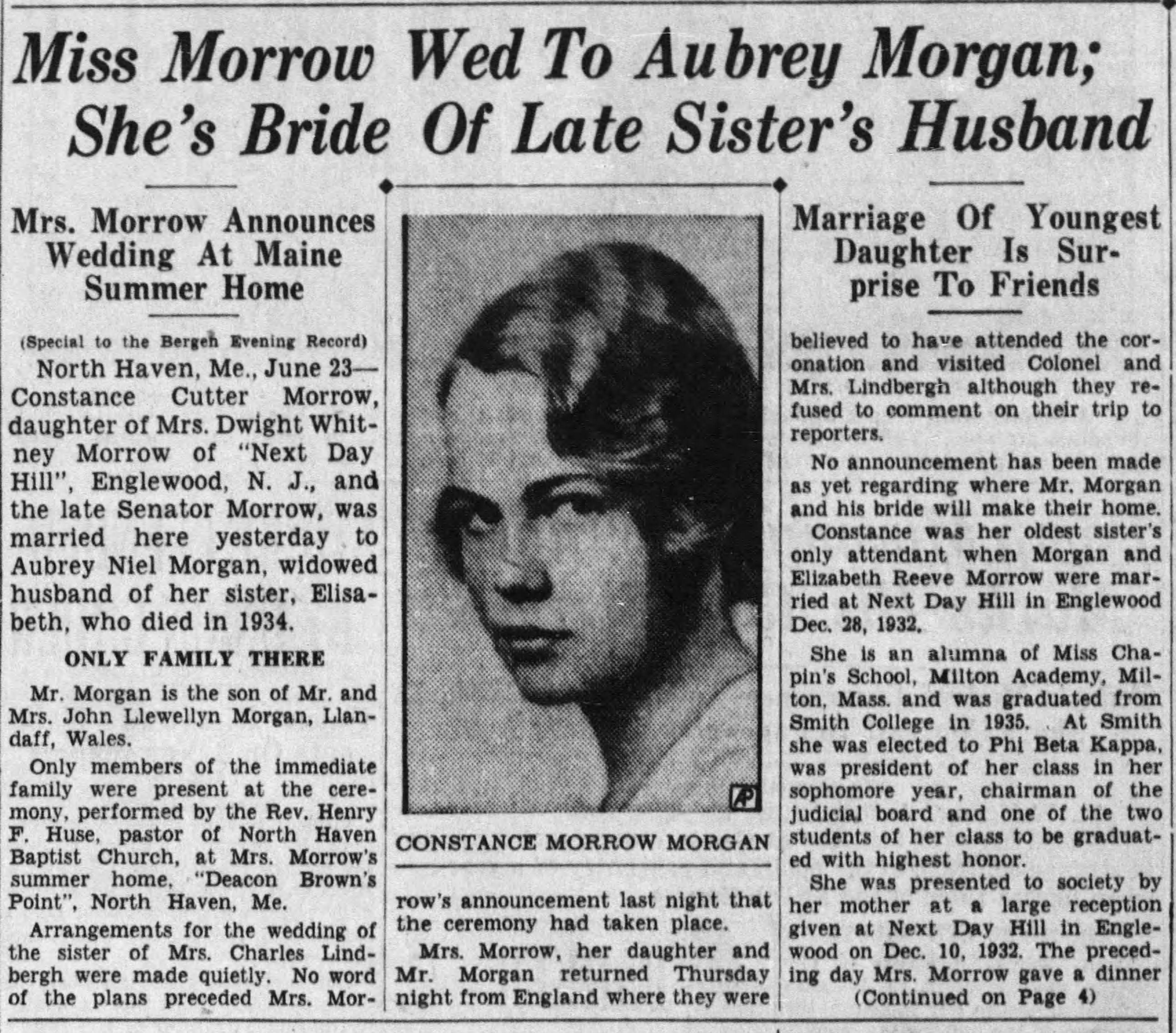The Independent:
Wednesday, 29 March 1995
Constance Morgan was a former chairman of the Board of Trustees of Smith College, America's leading female university. She played an influential role in the British Information Services in New York during the Second World War and at the British Embassy in Washington after it, and was also the sister-in-law of Colonel Charles Lindbergh, the aviation hero and America Firster.
Con was the youngest of the three daughters of Senator Dwight Morrow, a senior partner in the prestigious international banking firm of J.P. Morgan, and she accompanied her father when the President, Calvin Coolidge, appointed him American Ambassador to Mexico. In December 1927, Ambassador Morrow persuaded Charles Lindbergh to fly down to Mexico City in The Spirit of St Louis, the plane which, earlier that year, he had piloted from New York to Paris, making the first solo crossing of the Atlantic. Lindbergh fell in love with Morrow's second daughter, Anne, a beautiful and cultured girl. Eighteen months later they were married.
In 1932 the abduction of the Lindberghs' first-born son, Charlie, followed by a demand for a ransom, which was paid, and the eventual discovery that the child had been murdered, caused a world sensation. A German carpenter, Bruno Hauptmann, was .... (a) culprit and later electrocuted. The Lindberghs were telephoned the news of his arrest while staying in California with the eldest of the Morrow daughters, Elisabeth. Later that year Elisabeth married Aubrey Niel Morgan, the grandson of the founder of the Cardiff department store David Morgan Ltd. Elisabeth Morgan died prematurely of an incurable heart disease in 1934. Three years afterwards, Aubrey Morgan married Constance Morrow, thus becoming again the brother-in-law of the Lindberghs.
Con was then 23, petite and good-looking. She had graduated summa cum laude from Smith College, in Northampton, Massachusetts, where she was elected to Phi Beta Kappa, the top academic award. Following the publicity over the Lindbergh baby case she had had to be guarded at Smith by two plain-clothes policemen. Some three years beforehand she herself had been threatened with kidnapping and death unless $50,000 was paid for her safety. After her marriage she went on to earn her MA in English Literature from Columbia University in New York. She retained a deep interest in literature throughout her life.
In the summer of 1939, Sir Robert Vansittart, the British government's chief diplomatic adviser, privately recruited Aubrey Morgan and John Wheeler- Bennett, the historian and future biographer of King George VI, to revitalise the moribund British Library of Information in New York, so that the British voice might be effectively heard in America in the event of war. Accordingly, Aubrey and Con Morgan, together with a few friends, had virtually at their own expense set up a daily survey of the American media for the use of the Foreign Office and the Ministry of Information. In an office in Rockefeller Center, the British Press Service, nicknamed "the Clip Club", a team of writers under Con Morgan collated the material from various British consulates in the United States. It was a valuable source both for British officials in London and for Isaiah Berlin, then working at the British Embassy in Washington, for his droll weekly report on trends in America, which Winston Churchill always read with great interest. The activities of the British Library of Information and the British Press Service were eventually transformed into the British Information Services and Morgan was put in charge.
By this time Lindbergh was ... (a leading spokesman) of America First, the leading isolationist pressure group. Goering had convinced him shortly before the war that Britain could not withstand the might of the Luftwaffe, and Anne Lindbergh shared her husband's views. The Morrow family was thus deeply divided in the debate over American neutrality.When a Life journalist asked Morgan about his relationship with his famous brother-in-law, he replied that his obvious inability to change Lindbergh's mind refuted the myth of the invincibility of British propaganda.
After the war the Morgans took up residence at their farm at Ridgefield, in the south-west of Washington State, where they raised a splendid herd of dairy cattle and marketed timber from huge Douglas firs. They had bought the property during the war as a possible retreat for Welsh relatives should Britain be successfully invaded. They had been there but a couple of years when Wheeler-Bennett persuaded Morgan to fly to Oxford on what he described as "a matter of national interest". It was to urge him to become the personal assistant and counsellor on Anglo-American relations to the new British Ambassador to Washington, Sir Oliver Franks. Morgan was loath to accept. He felt he had done his stint as a government servant and wished to continue farming. But Franks's charm and the attraction of his remarkably lucid mind won him over and the Morgans moved to Washington.
Con Morgan was a great social asset to the Embassy circle and for the next five years continued to forge strong links between the United Kingdom and the United States. In 1953 she returned to the Pacific North-west with her husband and their four children. She devoted much of the rest of her life to educational and philanthropic causes. She served on the board of Smith College from 1956 to 1971, and was chairman of it for four years. She was also a trustee of the Marshall Fellows Program. Constance Morgan wrote A Distant Moment (1970), a biography of her mother, also an intellectual woman of great charm, who had been chairman of the Smith board.
byline: Leonard Miall
The Independent:
Wednesday, 29 March 1995
Constance Morgan was a former chairman of the Board of Trustees of Smith College, America's leading female university. She played an influential role in the British Information Services in New York during the Second World War and at the British Embassy in Washington after it, and was also the sister-in-law of Colonel Charles Lindbergh, the aviation hero and America Firster.
Con was the youngest of the three daughters of Senator Dwight Morrow, a senior partner in the prestigious international banking firm of J.P. Morgan, and she accompanied her father when the President, Calvin Coolidge, appointed him American Ambassador to Mexico. In December 1927, Ambassador Morrow persuaded Charles Lindbergh to fly down to Mexico City in The Spirit of St Louis, the plane which, earlier that year, he had piloted from New York to Paris, making the first solo crossing of the Atlantic. Lindbergh fell in love with Morrow's second daughter, Anne, a beautiful and cultured girl. Eighteen months later they were married.
In 1932 the abduction of the Lindberghs' first-born son, Charlie, followed by a demand for a ransom, which was paid, and the eventual discovery that the child had been murdered, caused a world sensation. A German carpenter, Bruno Hauptmann, was .... (a) culprit and later electrocuted. The Lindberghs were telephoned the news of his arrest while staying in California with the eldest of the Morrow daughters, Elisabeth. Later that year Elisabeth married Aubrey Niel Morgan, the grandson of the founder of the Cardiff department store David Morgan Ltd. Elisabeth Morgan died prematurely of an incurable heart disease in 1934. Three years afterwards, Aubrey Morgan married Constance Morrow, thus becoming again the brother-in-law of the Lindberghs.
Con was then 23, petite and good-looking. She had graduated summa cum laude from Smith College, in Northampton, Massachusetts, where she was elected to Phi Beta Kappa, the top academic award. Following the publicity over the Lindbergh baby case she had had to be guarded at Smith by two plain-clothes policemen. Some three years beforehand she herself had been threatened with kidnapping and death unless $50,000 was paid for her safety. After her marriage she went on to earn her MA in English Literature from Columbia University in New York. She retained a deep interest in literature throughout her life.
In the summer of 1939, Sir Robert Vansittart, the British government's chief diplomatic adviser, privately recruited Aubrey Morgan and John Wheeler- Bennett, the historian and future biographer of King George VI, to revitalise the moribund British Library of Information in New York, so that the British voice might be effectively heard in America in the event of war. Accordingly, Aubrey and Con Morgan, together with a few friends, had virtually at their own expense set up a daily survey of the American media for the use of the Foreign Office and the Ministry of Information. In an office in Rockefeller Center, the British Press Service, nicknamed "the Clip Club", a team of writers under Con Morgan collated the material from various British consulates in the United States. It was a valuable source both for British officials in London and for Isaiah Berlin, then working at the British Embassy in Washington, for his droll weekly report on trends in America, which Winston Churchill always read with great interest. The activities of the British Library of Information and the British Press Service were eventually transformed into the British Information Services and Morgan was put in charge.
By this time Lindbergh was ... (a leading spokesman) of America First, the leading isolationist pressure group. Goering had convinced him shortly before the war that Britain could not withstand the might of the Luftwaffe, and Anne Lindbergh shared her husband's views. The Morrow family was thus deeply divided in the debate over American neutrality.When a Life journalist asked Morgan about his relationship with his famous brother-in-law, he replied that his obvious inability to change Lindbergh's mind refuted the myth of the invincibility of British propaganda.
After the war the Morgans took up residence at their farm at Ridgefield, in the south-west of Washington State, where they raised a splendid herd of dairy cattle and marketed timber from huge Douglas firs. They had bought the property during the war as a possible retreat for Welsh relatives should Britain be successfully invaded. They had been there but a couple of years when Wheeler-Bennett persuaded Morgan to fly to Oxford on what he described as "a matter of national interest". It was to urge him to become the personal assistant and counsellor on Anglo-American relations to the new British Ambassador to Washington, Sir Oliver Franks. Morgan was loath to accept. He felt he had done his stint as a government servant and wished to continue farming. But Franks's charm and the attraction of his remarkably lucid mind won him over and the Morgans moved to Washington.
Con Morgan was a great social asset to the Embassy circle and for the next five years continued to forge strong links between the United Kingdom and the United States. In 1953 she returned to the Pacific North-west with her husband and their four children. She devoted much of the rest of her life to educational and philanthropic causes. She served on the board of Smith College from 1956 to 1971, and was chairman of it for four years. She was also a trustee of the Marshall Fellows Program. Constance Morgan wrote A Distant Moment (1970), a biography of her mother, also an intellectual woman of great charm, who had been chairman of the Smith board.
byline: Leonard Miall
Family Members
Sponsored by Ancestry
Advertisement
Advertisement












